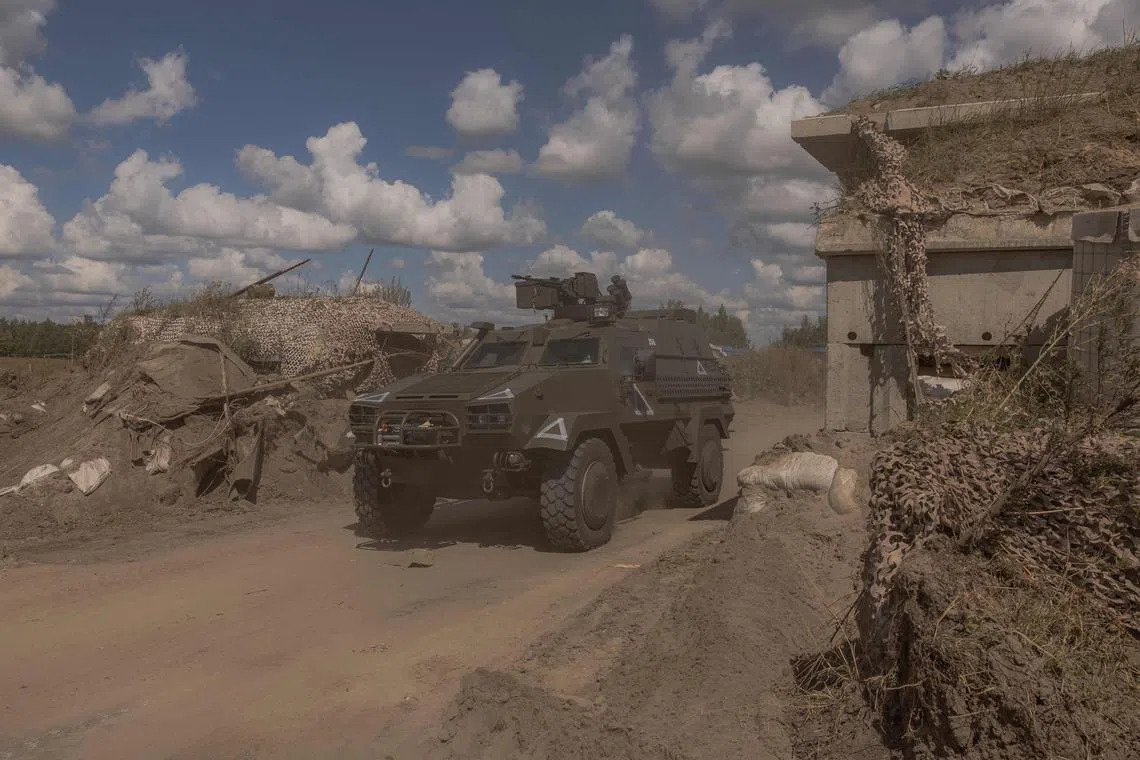Ukraine says advance into Russia ‘going well’, creates strategic buffer
Sign up now: Get ST's newsletters delivered to your inbox

A Ukrainian military vehicle driving past a destroyed border crossing point with Russia, in the Sumy region, on Aug 14.
PHOTO: AFP
Follow topic:
KYIV – Ukraine’s forces advanced farther into Russia’s Kursk region on Aug 14 as Kyiv said its gains would provide a strategic buffer zone to protect its border areas from Russian attacks.
Kyiv’s surge into Russian territory
Ukrainian President Volodymyr Zelensky met top officials to discuss the humanitarian situation and possible establishment of military administrations in an occupied area that Ukraine says exceeds 1,000 sq km.
“We continue to advance farther in the Kursk region,” Mr Zelensky wrote on Telegram, “from 1km to 2km in various areas since the start of the day”.
Later, in his nightly address, he referred to the growing number of Russian prisoners of war taken in the Kursk region who could be exchanged for Ukrainian fighters.
“Our advance in the Kursk region is going well today – we are reaching our strategic goal. The ‘exchange fund’ for our state has also been significantly replenished.”
Interior Minister Ihor Klymenko said the creation of a “buffer zone” was “designed to protect our border communities from daily enemy attacks”.
Russia has been pummelling Ukraine with strikes launched from adjacent border territories,
Ukraine complains that its defence against such attacks has been hamstrung by the need to respect Western countries’ compunction about using their weapons against Russia’s hinterland rather than against its forces in occupied Ukraine.
Long-range strikes
Carving out a slice of the Kursk region – which Russia puts at less than half the area claimed by Ukraine – will help that cause, though Mr Zelensky once more urged Western allies to permit long-range missile strikes into Russia.
Russian President Vladimir Putin has vowed to expel the Ukrainian troops, which he says aim, with Western backing, to give Kyiv a stronger hand in possible future ceasefire talks. But more than a week of intense battles have so far failed to oust them.
“The situation remains difficult,” said Mr Yuri Podolyaka, an influential Ukrainian-born, pro-Russian military blogger.
Moscow said 117 Ukrainian drones had been shot down over Russia overnight, mostly in the Kursk, Voronezh, Belgorod and Nizhny Novgorod regions. It said missiles had also been downed, and showed Sukhoi Su-34 bombers striking what it said were Ukrainian positions in the Kursk region.
Later, Russia’s Defence Ministry said its forces had repelled a series of Ukrainian attacks inside the Kursk region, including at Russkoye Porechnoye, 18km from the border. Some pro-Russian war bloggers said the front had been stabilised, while state television said Moscow’s forces were turning the tide.
Some Ukrainian drones attacked four Russian military airfields, seeking to undermine Russia’s ability to attack Ukraine with glide bombs, a Ukrainian security source told Reuters on condition of anonymity.
Ukraine’s military said it had destroyed a Russian Su-34 fighter jet.
Russia’s National Guard said it was beefing up security at the Kursk nuclear power plant, just 35km from the fighting.
In the Russian border region of Belgorod, governor Vyacheslav Gladkov declared a state of emergency.
Russia says it has already evacuated about 200,000 people from the border zone.
Evacuation corridors
Ukrainian Deputy Prime Minister Iryna Vereshchuk said Kyiv would open humanitarian corridors for evacuating civilians towards both Russia and Ukraine.
Ukrainian officials said Kyiv would also arrange access for international humanitarian organisations, likely to include the International Committee of the Red Cross and the United Nations.
The unprecedented incursion carries major risks for Russia, Ukraine and the West, which is keen to avoid a direct confrontation between Russia and the US-led Nato military alliance that has helped arm Ukraine.
US President Joe Biden said US officials were in constant touch with Kyiv over the incursion, although the White House said Washington had not received advance notice and had no involvement.
Russian officials say Ukraine’s Western backers must have known of the attack. “Of course they are involved,” lawmaker Maria Butina told Reuters.
The offensive could leave Ukrainian forces more exposed on other parts of the front, where Russia has been slowly adding to the 18 per cent of Ukrainian territory it now controls.
The heaviest fighting is still in the Donetsk region, and Mr Zelensky said his forces there would receive more weapons than planned from the next Western support package.
Ukraine’s top commander, Colonel-General Oleksandr Syrskyi, said the Russian town of Sudzha, a transhipment hub for Russian natural gas flowing to Europe via Ukraine, was fully under Ukrainian control. Natural gas was still flowing on Aug 14.
The Russian rouble fell further against the dollar on Aug 14, for a loss of over 8 per cent since the incursion began. REUTERS

